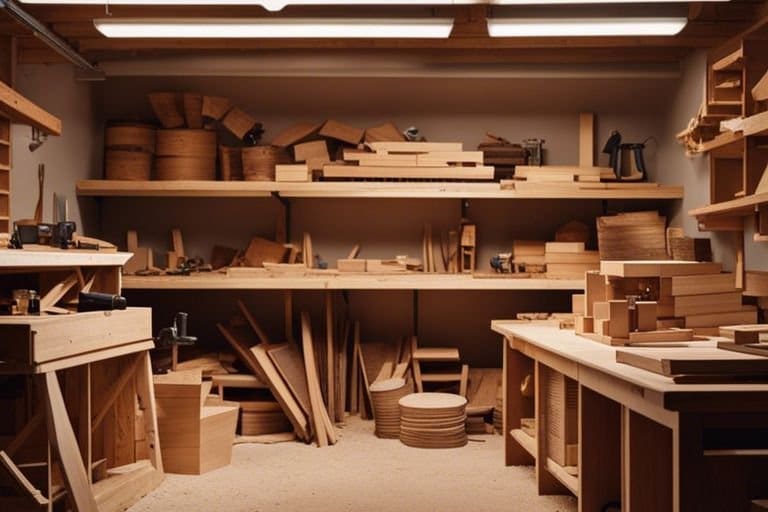Most woodworkers know that achieving precision cuts is the holy grail of any project. But fear not, fellow artisans! In this blog post, we will investigate into the world of rare saw options that can take your woodworking game to the next level! From Japanese pull saws to double-edge flush trim saws, we’ve got you covered. So grab your favorite mug of strong coffee and let’s explore these unique tools together!
The Importance of Precision Cuts
Why Accuracy Matters in Woodworking
Importance of precision cuts in woodworking cannot be overstated. Whether you are building a table, a cabinet, or a deck, the accuracy of your cuts directly impacts the quality and durability of the final product. A precise cut ensures that all pieces fit together seamlessly, creating a professional-looking finish. It also minimizes mistakes and reduces the need for adjustments or fixes later on, saving you time and frustration.
Common Mistakes to Avoid
Importance of avoiding common mistakes in woodworking cannot be emphasized enough. One of the most frequent errors is rushing through cuts without measuring properly. Note, measure twice, cut once! Another common mistake is not using the right saw for the job. Each saw is designed for specific cuts, so using the wrong one can result in inaccuracies and rough edges.
Plus, always double-check your measurements and take your time with each cut. It’s better to work slowly and accurately than to rush and make costly mistakes. By avoiding these common pitfalls, you’ll be well on your way to mastering the art of precision cuts in woodworking.
Rare Tool Options for Precision Cuts
While there are plenty of saw options out there for making precise cuts, some rare tools truly stand out for their exceptional craftsmanship and precision. From Japanese handsaws to Gent’s saws and Dovetail saws, these unique tools offer woodworkers a cut above the rest when it comes to achieving impeccable cuts.
Japanese Handsaws: A Cut Above the Rest
With a rich history dating back centuries, Japanese handsaws are revered for their razor-sharp teeth and incredibly thin blades, allowing for unmatched precision when cutting through wood. These handsaws cut on the pull stroke rather than the push stroke like Western saws, resulting in cleaner and more accurate cuts. The unique design of Japanese handsaws also reduces the chances of tear-out, making them ideal for fine woodworking projects that require utmost precision.
Gent’s Saw: The Pocket-Sized Precision Pro
One of the most underrated tools in the woodworking world, the Gent’s saw is a compact and lightweight saw that packs a punch when it comes to precision cuts. Perfect for delicate work and intricate detail, this pocket-sized saw is a favorite among woodworkers who value precision above all else. Its smaller size allows for greater control and maneuverability, making it an crucial tool for cutting tight joints and fine details with ease.
Rarely seen in modern workshops, the Gent’s saw harkens back to a time when craftsmanship and precision were paramount. Its small size and delicate blade make it a hidden gem in the world of precision cutting tools, offering woodworkers the ability to achieve flawless cuts that truly stand out.
Dovetail Saw: The Master of Fine Cuts
Options for precision cuts wouldn’t be complete without mentioning the Dovetail saw. This specialized saw is specifically designed for creating tight-fitting dovetail joints, making it a master of fine cuts in the woodworking realm. With its fine teeth and narrow blade, the Dovetail saw excels at making clean and precise cuts that are crucial for crafting beautiful, handcrafted furniture pieces and intricate joinery.
Precision is the name of the game when it comes to the Dovetail saw. Its ability to create seamless and precise cuts is unmatched, making it a must-have tool for any woodworker striving for perfection in their craft.
Hand Saw Options for Precision Cuts
Once again, we find ourselves in the delightful world of hand saws, where craftsmanship meets precision with every stroke. Concerning making intricate cuts, hand saws are crucial tools that every woodworker should have in their arsenal. Let’s probe into some rare and exceptional hand saw options that can help you achieve those precise cuts you desire.
Western-Style Handsaws: The Classic Choice
Western-style handsaws, with their classic design and trusted functionality, have been the weapon of choice for woodworkers for centuries. These saws are ideal for making precise cuts thanks to their rigid blade and fine teeth that allow for clean slicing through wood. Whether you’re working on a detailed woodworking project or need to trim a piece with accuracy, a Western-style handsaw is a reliable companion that won’t let you down.
High-Carbon Steel Handsaws: Sharp and Reliable
Hand saws crafted from high-carbon steel deserve a special place in the heart of precision-seeking woodworkers. Known for their sharpness and durability, these handsaws can effortlessly glide through wood, leaving behind smooth and accurate cuts. With a high-carbon steel handsaw in hand, you can tackle intricate designs and delicate woodworking tasks with ease, knowing that your tool will deliver consistent and reliable performance.
Precision is the name of the game when it comes to high-carbon steel handsaws. These tools are designed to provide woodworkers with the sharpness and control needed to execute detailed cuts with finesse. Whether you’re cutting dovetails, tenons, or creating joinery, a high-carbon steel handsaw will be your trusted ally in achieving precise results every time.
Ergonomic Handles: Comfort Meets Precision
Steel yourself for a woodworking experience like no other with ergonomic handle hand saws. These innovative saws not only prioritize precision cutting but also ensure that your comfort is taken into consideration. The ergonomic handles are designed to reduce strain on your hands and wrists, allowing you to focus on the task at hand without any discomfort.
Reliable and comfortable, ergonomic handle hand saws take precision cutting to the next level. Say goodbye to hand fatigue and hello to smooth, accurate cuts that will make your woodworking projects a breeze. With an ergonomic handle hand saw in your toolkit, you’ll be able to tackle even the most intricate cuts with ease and finesse.
Power Tool Options for Precision Cuts
Miter Saws: The Accurate Cutters
One of the power tool options for precision cuts is the trusty miter saw. These bad boys are known for their ability to make precise angled cuts with ease. Whether you’re working on crown molding or framing a picture-perfect deck, a miter saw is your go-to tool for accuracy. With their handy rotating blade and adjustable angles, you can trust a miter saw to deliver clean and precise cuts every time.
Circular Saws: The Fast and Furious
Fast and powerful, circular saws are like the muscle cars of the power tool world. These handheld wonders are perfect for making quick and straight cuts, ideal for when you need speed without sacrificing accuracy. Whether you’re cutting through hardwood or plywood, a circular saw will get the job done in no time.
Plus, with their lightweight design and maneuverability, circular saws are great for those tight spaces where other saws might struggle to reach. Just remember to keep a steady hand and let the saw do the work for you!
Jigsaws: The Curvy Cut Specialists
Furious about making intricate and curved cuts? Look no further than the jigsaw. These versatile tools are perfect for cutting curves, circles, and other irregular shapes with precision. Whether you’re working on a custom furniture piece or crafting a unique design, a jigsaw is your go-to tool for those special cuts that require finesse.
Power up your woodworking game with these precision power tools, and you’ll be crafting like a pro in no time!
Choosing the Right Saw for Your Project
Many factors come into play when selecting the right saw for your woodworking project. From the type of material you’re working with to your skill level, each element plays a crucial role in determining which saw will deliver the precision cuts you desire.
Consider the Material: Wood Type and Thickness
With woodworking, the type of wood and its thickness can greatly impact your choice of saw. For softer woods like pine, a fine-toothed saw may be more suitable for clean cuts. However, denser woods like oak may require a saw with larger teeth and more power to slice through effectively. Additionally, the thickness of the wood plays a role in selecting the proper saw, as thicker pieces may require a saw with more depth and power to handle the job efficiently.
Think About the Cut: Rip, Crosscut, or Miter?
The type of cut you need to make is another critical factor in choosing the right saw for your project. Ripping cuts are made along the grain of the wood, crosscuts go across the grain, and miter cuts are angled cuts for corners and joints. Each type of cut requires a different saw blade and set up for optimal results.
The
Your Skill Level: Beginner, Intermediate, or Pro?
Choosing the right saw also depends on your skill level in woodworking. Beginners may find it easier to start with a basic handsaw or a circular saw for simpler cuts, while intermediate woodworkers may be comfortable using a table saw or miter saw for more precision. Professionals with advanced skills may opt for a more specialized saw like a band saw or scroll saw for intricate and detailed work.
Consider your skill level and comfort with different saws to ensure you select the right tool that matches your expertise and delivers the precision cuts you need for your project.
Tips and Tricks for Achieving Precision Cuts
All craftsmen know that achieving precision cuts is the holy grail of woodworking. It requires skill, patience, and the right tools. Here are some tips and tricks to help you master the art of precision cutting and take your woodworking game to the next level.
Measure Twice, Cut Once: The Importance of Measurement
On the journey to precision cuts, there is one rule that is non-negotiable: always measure twice, cut once. Taking the time to double-check your measurements before making any cuts can save you from costly mistakes and wasted materials. Keep in mind, in woodworking, there is no such thing as a “just okay” measurement. Every fraction of an inch matters when striving for perfection.
Any seasoned woodworker will tell you that investing in a good quality tape measure and a reliable square is worth its weight in gold. These simple tools are your allies in the fight against inaccuracy and will help you achieve the precision you desire in your cuts.
Marking Your Cuts: Pencils, Marking Gauges, and More
Cuts in woodworking are like lines on a map – they guide you to your destination. Using the right tools to mark your cuts is important for staying on course and ensuring accuracy in your work. Pencils, marking gauges, and even a sharp knife can be invaluable when it comes to marking out your cuts.
Tips:
– Always use a sharp pencil or knife for marking your cuts. A dull tool can lead to imprecise markings and ultimately, inaccurate cuts.
– Consider using a marking gauge for consistent and uniform lines. This tool will help you create precise markings that are important for making accurate cuts.
Cutting Techniques: Slow and Steady Wins the Race
Your cutting technique is just as important as the tools you use. When considering precision cuts, remember that slow and steady wins the race. Rushing through a cut can lead to errors and imperfections that are difficult to fix.
Marking your cut line accurately and using a steady hand to guide your saw along the path will result in clean and precise cuts. Take your time, let the saw do the work, and maintain a steady pace to ensure that your cuts are accurate and smooth.
Marking:
In the world of woodworking, precision cuts are the hallmark of a skilled craftsman. By following these tips and tricks, you’ll be well on your way to mastering the art of precision cutting and taking your woodworking projects to the next level. Keep in mind, practice makes perfect, so don’t get discouraged if you don’t achieve perfection right away. Keep honing your skills, stay patient, and enjoy the journey of creating beautiful pieces with precision and care.
To wrap up
Ultimately, when it comes to making precision cuts, the best saw for the job will depend on the specific project and materials you are working with. Traditional options like the table saw and miter saw are great choices for most woodworking tasks, but don’t be afraid to explore rare tools like the Japanese pull saw or carving gouges for those unique, intricate cuts. Note, the key to achieving precision cuts is not only having the right tool but also taking the time to measure, mark, and make careful adjustments as needed.




